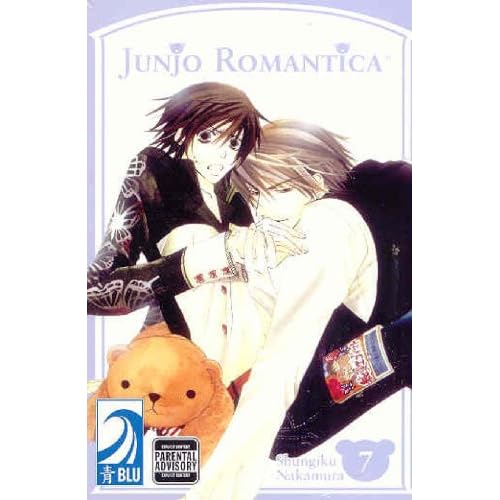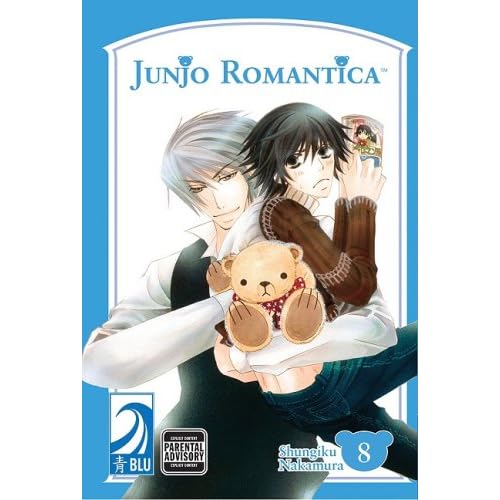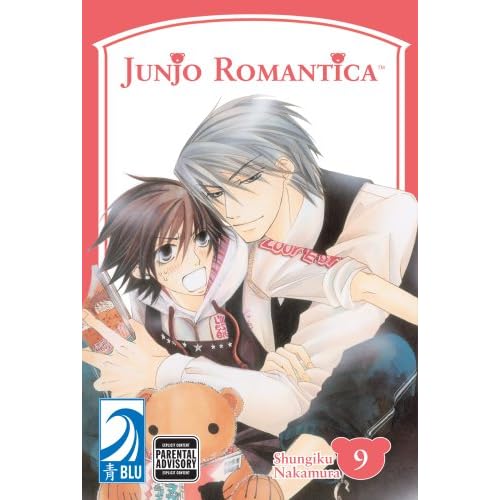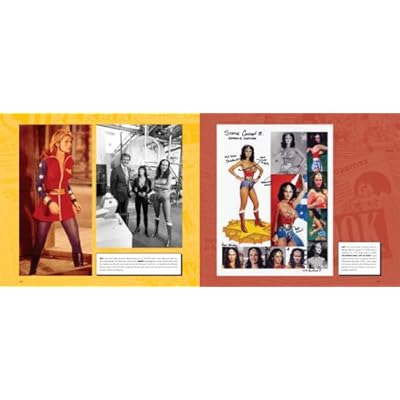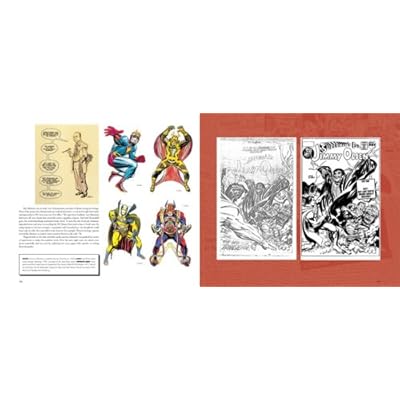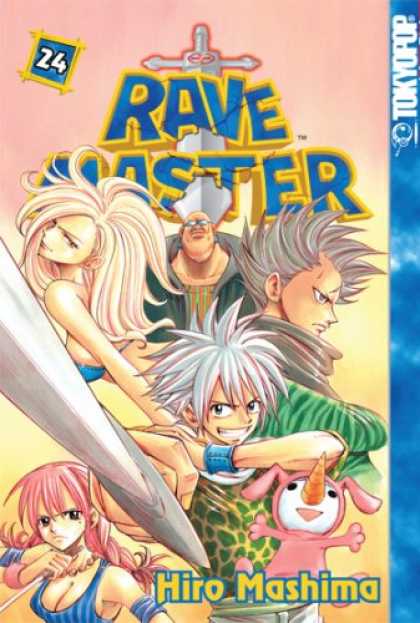
Rabu, 15 April 2009
Minggu, 12 April 2009
Vampire Knight, Vol. 6

Cross Adademy is attended by two groups of students: the Day Class and the Night Class. At twilight, when the students of the Day Class return to their dorm, they cross paths with the Night Class on their way to school. Yuki Cross and Zero Kiryu are the Guardians of the school, protecting the Day Class from the Academy's dark secret: the Night Class is full of vampires!
Yuki sneaks into an exclusive vampire party and sees Aido's parents introducing their daughter to Kaname. They, like many other Night Class parents, desire an alliance with the pureblood. Kaname is the most eligible bachelor in the vampire society--but will he choose Yuki?
Jumat, 10 April 2009
Red River 21

Prince Kail, a young warrior and sorcerer, and Yuri, a modern-day teen, were thrown together when Queen Nakia drew Yuri across time and space into the ancient Hittite Empire. When it is the season of the North Star, Prince Kail has the power to send Yuri home. But the evil queen's plan to murder them both--and their growing feelings for one another--keep getting in the way!
Charged with treason, Nakia is interrogated by the Hittite council of ministers. Nakia denies her guilt and, despite being confined, uses her magic to free her henchman Urhi, who is then suspected of launching a campaign of murderous retaliation against Kail and Yuri. Nakia, however, seems to have made one mistake that could undo all her schemes--overlooking the devastating effect all the intrigue and treachery has had on Juda, her son and intended heir to the Hittite throne!Rabu, 08 April 2009
Fruits Basket, Vol. 22 (Paperback) by Natsuki Takaya (Author)
Selasa, 07 April 2009
The Dark-Hunters

In the war against vampires, mankind has only one hope: The Dark-Hunters. Ancient warriors who died of brutal betrayal, the Dark-Hunters have sworn themselves into the service of the goddess Artemis to protect us. It’s a pact with pretty good perks. Immortality, power, psychic abilities, wealth and a cool wardrobe. But it comes with a few drawbacks: fatal sun poisoning and a new, irreparable dental problem. But aside from the fangs and nocturnal lifestyle, it’s not so bad. Until Kyrian meets the most frightening thing imaginable. An accountant who’s being hunted by one of the most lethal vampires out there. If Amanda Devereaux goes down, so does he and no offense, he doesn’t want to die (hence the whole immortality thing). And he doesn’t want humanity dead either which is a good thing for us since he and Amanda are all that stands between us and oblivion. Let’s hope they win.
Senin, 06 April 2009
Death Note: Another Note

This book is a prequel to the Death Note series. It covers the Los Angeles BB Serial Murders that are briefly mentioned in the manga. It tells of the first time L ever worked with FBI Agent Naomi Misora, arguably his greatest collaborator.
What's interesting is that, unlike a lot of whodunnit mysteries, this one is actually more effective with a second reading. As a Death Note fan, I found the first reading of chapter two mildly intriguing. When I reread it after finishing the book and knowing who the killer was, that chapter became much darker, creepier, and more engaging. The same can be said about other parts of the book, but it was most effective here.
Jumat, 03 April 2009
The DC Vault: A Museum-in-a-Book with Rare Collectibles from the DC Universe [ILLUSTRATED] (Hardcover) by Martin Pasko (Author)
buy from amazon.com buy from amazon.com
buy from amazon.com
I like this even more than the Marvel Vault, which came out last year. The DC Vault has better content as far as the history of DC is concerned, starting with More Fun comics and leading up to recent history. Martin Pasko, who many longtime DC fans will remember as a key writer during the 1970s, wrote the text that accompanies the multitude of pictures and collectibles. He includes numerous typed and handwritten memos from DC Comics writers and editors that give us a fascinating inside look at how certain decisions were made.
Senin, 30 Maret 2009
Japanese comics

 The first comic books in Japan appeared during the 18th century in the form of woodblock- printed booklets containing short stories drawn from folk tales, legends, and historical accounts, told in a simple visual-verbal idiom. Known as "red books" (赤本 ,akahon?), "black books" (黒本 ,kurobon?), and "blue books" (青本 ,aohon?), these were written primarily for less literate readers. However, with the publication in 1775 of Koikawa Harumachi's comic book Master Flashgold's Splendiferous Dream (金々先生栄花の夢 ,Kinkin sensei eiga no yume?), an adult form of comic book originated, which required greater literacy and cultural sophistication. This was known as the kibyōshi (黄表紙?, lit. yellow cover). Published in thousands (possibly tens of thousands) of copies, the kibyōshi may have been the earliest fully realized comic book for adults in world literary history. Approximately 2000 titles remain extant. Modern comic books in Japan developed from a mixture of these earlier comic books and woodblock prints ukiyo-e (浮世絵 ?) with Western styles of drawing. They took their current[update] form shortly after World War II. They are usually published in black and white, except for the covers, which are usually printed in four colors, although occasionally, the first few pages may also be printed in full color. The term manga means "random (or whimsical) pictures", and first came into common usage in the late eighteenth century with the publication of such works as Santō Kyōden's picturebook Shiji no yukikai (四時交加 ?) (1798) and Aikawa Minwa's Comic Sketches of a Hundred Women (1798). Development of this form occurred as a result of Japan's attempts to modernize itself, a desire awakened by trade with the United States[citation needed]. Western artists were brought over to teach their students such concepts as line, form, and color, things which had not been regarded as conceptually important in ukiyo-e, as the idea behind the picture was of paramount importance. Manga at this time was referred to as Ponchi-e (Punch-picture) and, like its British counterpart Punch magazine, mainly depicted humour and political satire in short one- or four-picture format. Dr. Osamu Tezuka (1928-1989), widely acknowledged[by whom?] as the father of narrative manga, further developed this form. Tezuka was inspired to become a comic artist upon seeing an animation war propaganda film, titled Momotaro's Divine Sea Warriors (桃太郎 海の神兵 ,Momotarō Umi no Shinpei?). Tezuka introduced episodic storytelling and character development in comic format, in which each story is part of larger story arc. The only text in Tezuka's comics was the characters' dialogue and this further lent his comics a cinematic quality. Inspired by the work of Walt Disney, Tezuka also adopted a style of drawing facial features in which a character's eyes, nose, and mouth are drawn in an extremely exaggerated manner. This style created immediately recognizable expressions using very few lines, and the simplicity of this style allowed Tezuka to be prolific. Tezuka’s work generated new interest in the ukiyo-e tradition, in which the image is a representation of an idea, rather than a depiction of reality. Though a close equivalent to the American comic book, manga has historically held a more important place in Japanese culture than comics have in American culture. Japanese society shows a wide respect for manga: both as an art form and as a form of popular literature. Many manga become TV shows or shorter movies. As with its American counterpart, some manga has been criticized for its sexuality and violence, although in the absence of official or even industry restrictions on content, artists have been free to create manga for every age group and for every topic. Manga magazines — also known as "anthologies", or colloquially, "phone books"[citation needed] — often run several series concurrently, with approximately 20 to 40 pages allocated to each series per issue. These magazines are usually printed on low-quality newsprint and range from 200 to more than 850 pages each. Manga magazines also contain one-shot comics and a variety of four-panel yonkoma (equivalent to comic strips). Manga series may continue for many years if they are successful, with stories often collected and reprinted in book-sized volumes called tankōbon (単行本?, lit. stand-alone book), the equivalent of the American trade paperbacks. These volumes use higher-quality paper and are useful to readers who want to be brought up to date with a series, or to readers who find the cost of the weekly or monthly publications to be prohibitive. Deluxe versions are printed, as commemorative or collectible editions. Conversely, old manga titles are also reprinted using lower-quality paper and sold for 120 ¥ (approximately $1 USD) each.
The first comic books in Japan appeared during the 18th century in the form of woodblock- printed booklets containing short stories drawn from folk tales, legends, and historical accounts, told in a simple visual-verbal idiom. Known as "red books" (赤本 ,akahon?), "black books" (黒本 ,kurobon?), and "blue books" (青本 ,aohon?), these were written primarily for less literate readers. However, with the publication in 1775 of Koikawa Harumachi's comic book Master Flashgold's Splendiferous Dream (金々先生栄花の夢 ,Kinkin sensei eiga no yume?), an adult form of comic book originated, which required greater literacy and cultural sophistication. This was known as the kibyōshi (黄表紙?, lit. yellow cover). Published in thousands (possibly tens of thousands) of copies, the kibyōshi may have been the earliest fully realized comic book for adults in world literary history. Approximately 2000 titles remain extant. Modern comic books in Japan developed from a mixture of these earlier comic books and woodblock prints ukiyo-e (浮世絵 ?) with Western styles of drawing. They took their current[update] form shortly after World War II. They are usually published in black and white, except for the covers, which are usually printed in four colors, although occasionally, the first few pages may also be printed in full color. The term manga means "random (or whimsical) pictures", and first came into common usage in the late eighteenth century with the publication of such works as Santō Kyōden's picturebook Shiji no yukikai (四時交加 ?) (1798) and Aikawa Minwa's Comic Sketches of a Hundred Women (1798). Development of this form occurred as a result of Japan's attempts to modernize itself, a desire awakened by trade with the United States[citation needed]. Western artists were brought over to teach their students such concepts as line, form, and color, things which had not been regarded as conceptually important in ukiyo-e, as the idea behind the picture was of paramount importance. Manga at this time was referred to as Ponchi-e (Punch-picture) and, like its British counterpart Punch magazine, mainly depicted humour and political satire in short one- or four-picture format. Dr. Osamu Tezuka (1928-1989), widely acknowledged[by whom?] as the father of narrative manga, further developed this form. Tezuka was inspired to become a comic artist upon seeing an animation war propaganda film, titled Momotaro's Divine Sea Warriors (桃太郎 海の神兵 ,Momotarō Umi no Shinpei?). Tezuka introduced episodic storytelling and character development in comic format, in which each story is part of larger story arc. The only text in Tezuka's comics was the characters' dialogue and this further lent his comics a cinematic quality. Inspired by the work of Walt Disney, Tezuka also adopted a style of drawing facial features in which a character's eyes, nose, and mouth are drawn in an extremely exaggerated manner. This style created immediately recognizable expressions using very few lines, and the simplicity of this style allowed Tezuka to be prolific. Tezuka’s work generated new interest in the ukiyo-e tradition, in which the image is a representation of an idea, rather than a depiction of reality. Though a close equivalent to the American comic book, manga has historically held a more important place in Japanese culture than comics have in American culture. Japanese society shows a wide respect for manga: both as an art form and as a form of popular literature. Many manga become TV shows or shorter movies. As with its American counterpart, some manga has been criticized for its sexuality and violence, although in the absence of official or even industry restrictions on content, artists have been free to create manga for every age group and for every topic. Manga magazines — also known as "anthologies", or colloquially, "phone books"[citation needed] — often run several series concurrently, with approximately 20 to 40 pages allocated to each series per issue. These magazines are usually printed on low-quality newsprint and range from 200 to more than 850 pages each. Manga magazines also contain one-shot comics and a variety of four-panel yonkoma (equivalent to comic strips). Manga series may continue for many years if they are successful, with stories often collected and reprinted in book-sized volumes called tankōbon (単行本?, lit. stand-alone book), the equivalent of the American trade paperbacks. These volumes use higher-quality paper and are useful to readers who want to be brought up to date with a series, or to readers who find the cost of the weekly or monthly publications to be prohibitive. Deluxe versions are printed, as commemorative or collectible editions. Conversely, old manga titles are also reprinted using lower-quality paper and sold for 120 ¥ (approximately $1 USD) each.
American Comics
Cultural historians divide the career of the comic book in the U.S. into several ages or historical eras: the Golden Age, the Silver Age, the Bronze Age, and the Modern Age. The exact boundaries of these eras, the terms for which originated in the fandom press, is a debatable point among comic book historians.
Adventures into Darkness, horror stories
The Golden Age is generally thought as lasting from the introduction of Jerry Siegel and Joe Shuster's Superman in 1938 until the late 1940s or early 1950s. During this time, comic books enjoyed considerable popularity; the archetype of the superhero was invented and defined, and many of the most popular superheroes were created. While comics as an art form could theoretically extend as far back in history as sequential cave paintings, comic books are dependent on printing, and the starting point for them in book form is generally considered to be the tabloid-sized The Funnies begun in 1929, or the smaller-sized Funnies on Parade begun in 1933. Both of these were simply reprints of newspaper strips.
The Silver Age of Comic Books is generally considered to date from the first successful revival of the dormant superhero form — the debut of Robert Kanigher and Carmine Infantino's Flash in Showcase #4 (September-October 1956) — and lasts through the early 1970s, during which time Marvel Comics revolutionized the medium with such naturalistic superheroes as Stan Lee and Jack Kirby's Fantastic Four and Stan Lee and Steve Ditko's Spider-Man. There is less agreement on the beginnings of the Bronze and Modern ages. Some suggest that the Bronze Age is still taking place. Starting points that have been suggested for the Bronze Age of comics are Roy Thomas and Barry Windsor-Smith's Conan #1 (October 1970), Denny O'Neil and Neal Adams' Green Lantern/Green Arrow #76 (April 1970) or Stan Lee and Gil Kane's Amazing Spider-Man #96 (May 1971) (the non-Comics Code issue). The start of the Modern Age (occasionally referred to as the Iron Age) has even more potential starting points, but is generally agreed to be the publication of Frank Miller's Batman: The Dark Knight Returns graphic novel and Alan Moore's Watchmen by DC Comics in 1986.
Comics published after World War II in 1945 are sometimes referred to as being from the Atomic Age (referring to the dropping of the atomic bomb), while titles published after November 1961 are sometimes referred to as being from the Marvel Age (referring to the advent of Marvel Comics). However, these eras are referred to far less frequently than the aforementioned designations.
Notable events in the history of the American comic book include the psychiatrist Fredric Wertham's criticisms of the medium in his book Seduction of the Innocent, which prompted the Senate Subcommittee on Juvenile Delinquency to investigate comic books. In response to this attention from both the government and the media, the US comic book industry created the Comics Code Authority in 1954 and drafted the Comics Code.

